| Western blot (WB): | 1:500-2000 |
| Immunohistochemistry (IHC): | 1:50-400 |
| Flow Cytometry (Fixed): | 1:50-200 |
| (Boiling the paraffin sections in 10mM citrate buffer,pH6.0,or PH8.0 EDTA repair liquid for 20 mins is required for the staining of formalin/paraffin sections.) Optimal working dilutions must be determined by end user. | |
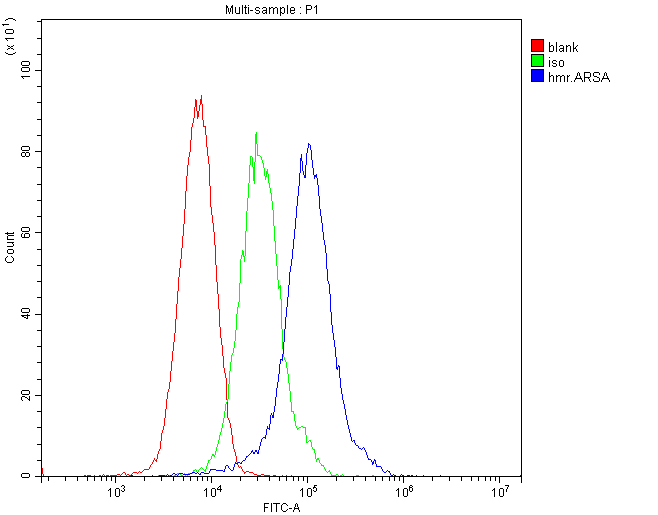
Flow Cytometry analysis of ANA-1 cells using anti-ARSA antibody (M02583).Overlay histogram showing ANA-1 cells stained with M02583 (Blue line).The cells were blocked with 10% normal goat serum. And then incubated with mouse anti-ARSA Antibody (M02583, 1:100) for 30 min at 20°C. DyLight488 conjugated goat anti-mouse IgG (BA1126, 1:100) was used as secondary antibody for 30 minutes at 20°C. Isotype control antibody (Green line) was mouse IgG (1:100) used under the same conditions. Unlabelled sample (Red line) was also used as a control.
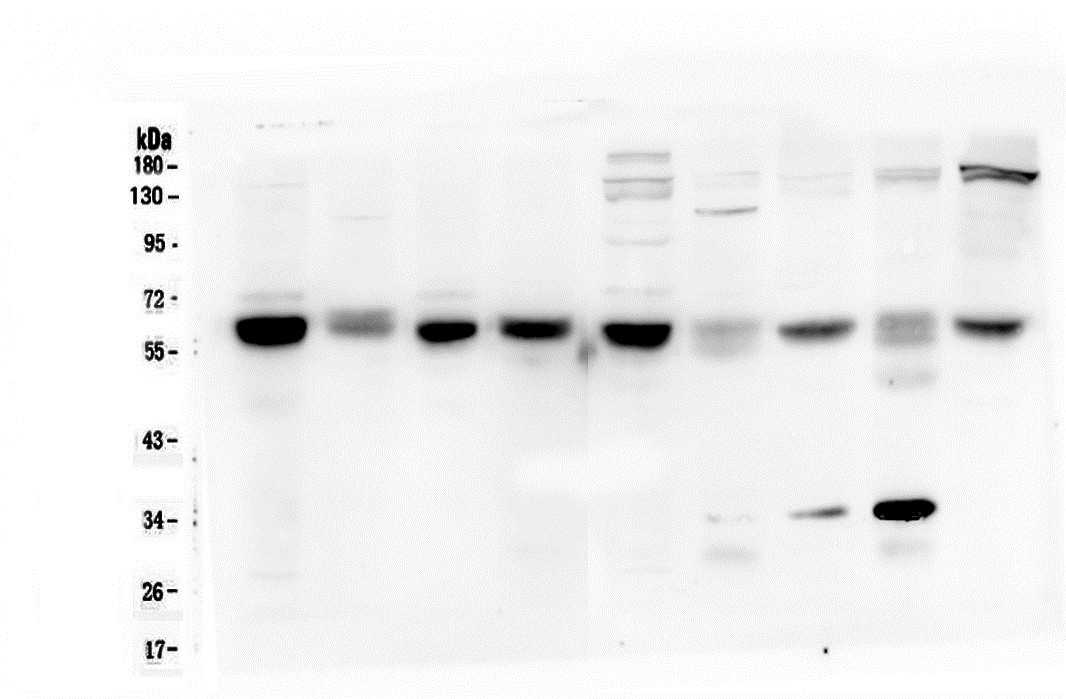
Western blot analysis of ARSA using anti-ARSA antibody (M02583). The sample well of each lane was loaded with 30 ug of sample under reducing conditions.
Lane 1: rat testis tissue lysates,
Lane 2: rat liver tissue lysates,
Lane 3: rat brain tissue lysates,
Lane 4: rat lung tissue lysates,
Lane 5: mouse testis tissue lysates,
Lane 6: mouse liver tissue lysates,
Lane 7: mouse brain tissue lysates,
Lane 8: mouse lung tissue lysates,
Lane 9: mouse HEPA1-6 whole cell lysates.
After electrophoresis, proteins were transferred to a membrane. Then the membrane was incubated with mouse anti-ARSA antigen affinity purified monoclonal antibody (M02583) at a dilution of 1:1000 and probed with a goat anti-mouse IgG-HRP secondary antibody (Catalog # BA1050). The signal is developed using ECL Plus Western Blotting Substrate (Catalog # AR1197). A specific band was detected for ARSA at approximately 54 kDa. The expected band size for ARSA is at 54 kDa.
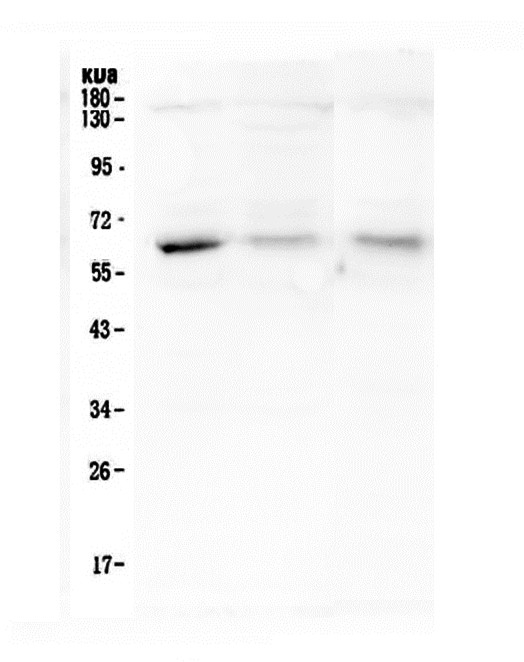
Western blot analysis of ARSA using anti-ARSA antibody (M02583). The sample well of each lane was loaded with 30 ug of sample under reducing conditions.
Lane 1: human A375 whole cell lysates,
Lane 2: human A549 whole cell lysates,
Lane 3: human SMMC-7721 whole cell lysates.
After electrophoresis, proteins were transferred to a membrane. Then the membrane was incubated with mouse anti-ARSA antigen affinity purified monoclonal antibody (M02583) at a dilution of 1:1000 and probed with a goat anti-mouse IgG-HRP secondary antibody (Catalog # BA1050). The signal is developed using ECL Plus Western Blotting Substrate (Catalog # AR1197). A specific band was detected for ARSA at approximately 54 kDa. The expected band size for ARSA is at 54 kDa.
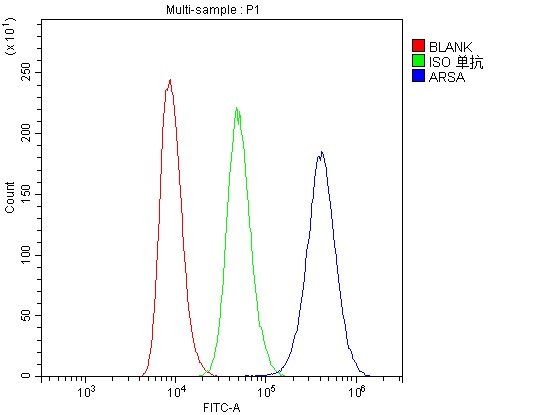
Flow Cytometry analysis of Raji cells using anti-ARSA antibody (M02583).
Overlay histogram showing Raji cells stained with M02583 (Blue line).The cells were blocked with 10% normal goat serum. And then incubated with mouse anti-ARSA Antibody (M02583, 1:100) for 30 min at 20°C. DyLight488 conjugated goat anti-mouse IgG (BA1127, 1:100) was used as secondary antibody for 30 minutes at 20°C. Isotype control antibody (Green line) was mouse IgG (1:100) used under the same conditions. Unlabelled sample (Red line) was also used as a control.
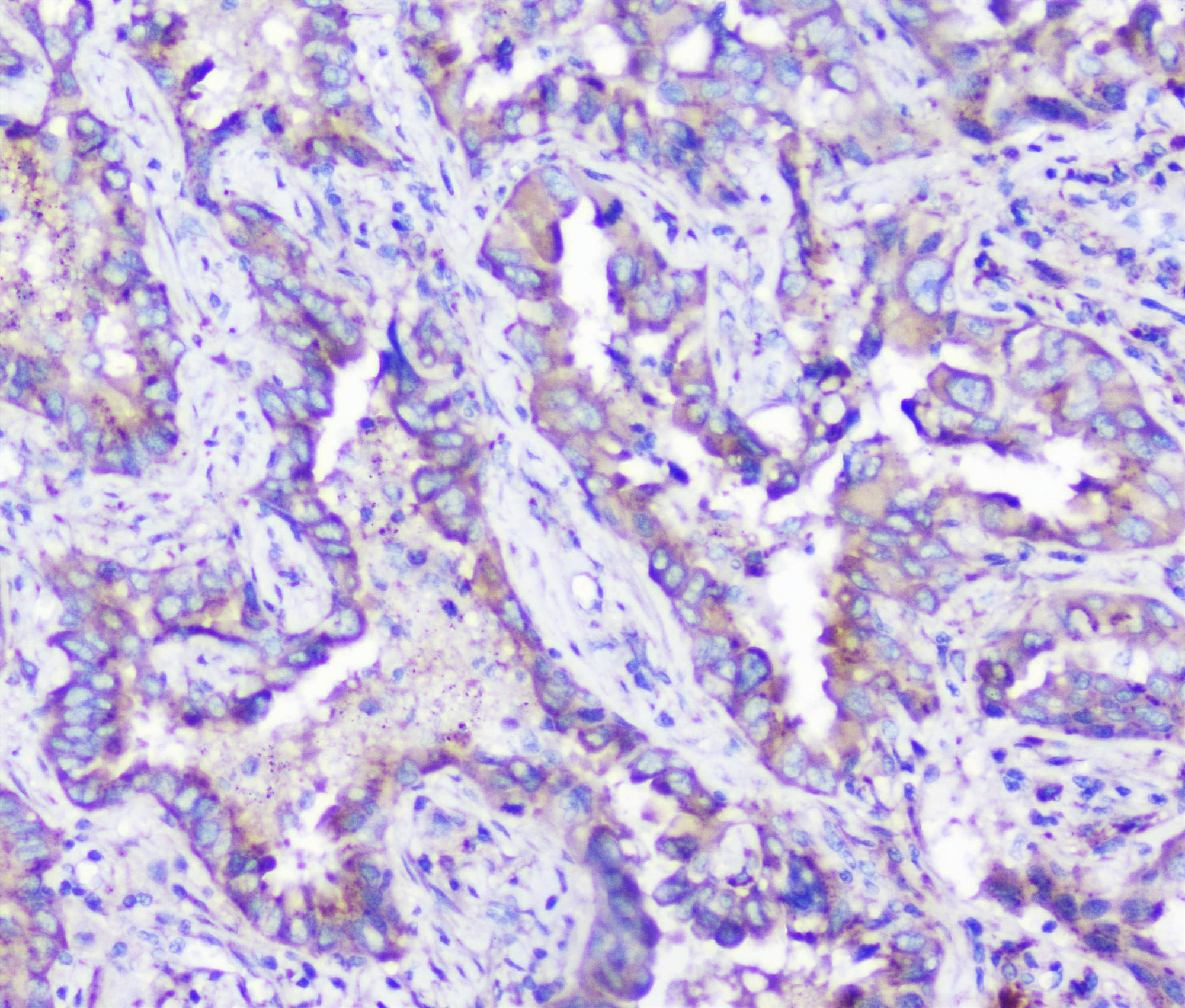
IHC analysis of ARSA using anti-ARSA antibody (M02583).
ARSA was detected in a paraffin-embedded section of human lung cancer tissue. Biotinylated goat anti-mouse IgG was used as secondary antibody. The tissue section was incubated with mouse anti-ARSA Antibody (M02583) at a dilution of 1:200 and developed using Strepavidin-Biotin-Complex (SABC) (Catalog # SA1021) with DAB (Catalog # AR1027) as the chromogen.

Flow Cytometry analysis of ANA-1 cells using anti-ARSA antibody (M02583).Overlay histogram showing ANA-1 cells stained with M02583 (Blue line).The cells were blocked with 10% normal goat serum. And then incubated with mouse anti-ARSA Antibody (M02583, 1:100) for 30 min at 20°C. DyLight488 conjugated goat anti-mouse IgG (BA1126, 1:100) was used as secondary antibody for 30 minutes at 20°C. Isotype control antibody (Green line) was mouse IgG (1:100) used under the same conditions. Unlabelled sample (Red line) was also used as a control.

Western blot analysis of ARSA using anti-ARSA antibody (M02583). The sample well of each lane was loaded with 30 ug of sample under reducing conditions.
Lane 1: rat testis tissue lysates,
Lane 2: rat liver tissue lysates,
Lane 3: rat brain tissue lysates,
Lane 4: rat lung tissue lysates,
Lane 5: mouse testis tissue lysates,
Lane 6: mouse liver tissue lysates,
Lane 7: mouse brain tissue lysates,
Lane 8: mouse lung tissue lysates,
Lane 9: mouse HEPA1-6 whole cell lysates.
After electrophoresis, proteins were transferred to a membrane. Then the membrane was incubated with mouse anti-ARSA antigen affinity purified monoclonal antibody (M02583) at a dilution of 1:1000 and probed with a goat anti-mouse IgG-HRP secondary antibody (Catalog # BA1050). The signal is developed using ECL Plus Western Blotting Substrate (Catalog # AR1197). A specific band was detected for ARSA at approximately 54 kDa. The expected band size for ARSA is at 54 kDa.

Western blot analysis of ARSA using anti-ARSA antibody (M02583). The sample well of each lane was loaded with 30 ug of sample under reducing conditions.
Lane 1: human A375 whole cell lysates,
Lane 2: human A549 whole cell lysates,
Lane 3: human SMMC-7721 whole cell lysates.
After electrophoresis, proteins were transferred to a membrane. Then the membrane was incubated with mouse anti-ARSA antigen affinity purified monoclonal antibody (M02583) at a dilution of 1:1000 and probed with a goat anti-mouse IgG-HRP secondary antibody (Catalog # BA1050). The signal is developed using ECL Plus Western Blotting Substrate (Catalog # AR1197). A specific band was detected for ARSA at approximately 54 kDa. The expected band size for ARSA is at 54 kDa.

Flow Cytometry analysis of Raji cells using anti-ARSA antibody (M02583).
Overlay histogram showing Raji cells stained with M02583 (Blue line).The cells were blocked with 10% normal goat serum. And then incubated with mouse anti-ARSA Antibody (M02583, 1:100) for 30 min at 20°C. DyLight488 conjugated goat anti-mouse IgG (BA1127, 1:100) was used as secondary antibody for 30 minutes at 20°C. Isotype control antibody (Green line) was mouse IgG (1:100) used under the same conditions. Unlabelled sample (Red line) was also used as a control.

IHC analysis of ARSA using anti-ARSA antibody (M02583).
ARSA was detected in a paraffin-embedded section of human lung cancer tissue. Biotinylated goat anti-mouse IgG was used as secondary antibody. The tissue section was incubated with mouse anti-ARSA Antibody (M02583) at a dilution of 1:200 and developed using Strepavidin-Biotin-Complex (SABC) (Catalog # SA1021) with DAB (Catalog # AR1027) as the chromogen.




